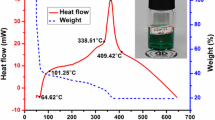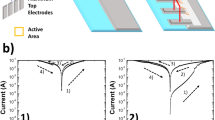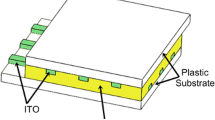Abstract
In this communication, we have tried to explain the experimental observation of the flow of opposite charge carriers (electrons and holes) in a Write Once Read Many times (WORM) type memory device’s resistive switching phenomena. A thiazine dye namely Toluidine Blue O (TBO) was used as the active layer. Bottom and top electrodes were taken as ITO and Au, respectively. The positions of HOMO and LUMO levels in TBO have been shown to play a crucial role in the flow of charge carriers upon applying a bias voltage. Depending on the positive and negative sweep voltages, the charge carriers have been exchanged. This confirmation was made on the basis of theoretical model, Density functional theory (DFT), and temperature-dependent studies. The devices also showed excellent retention capacity for more than 6 h. Memory window was having of the order of 103 and read endurance of greater than 3300 cycles. The device yield showed almost 80% and an excellent device stability of 90 days.










Similar content being viewed by others
Data availability
The research data those are included in this present work that is the manuscript and in the supplementary material will be made available on reasonable request to the corresponding author.
References
H. Lian, X. Cheng, H. Hao, J. Han, M.T. Lau, Z. Li, Z. Zhou, Q. Dong, W.Y. Wong, Metal-containing organic compounds for memory and data storage applications. Chem. Soc. Rev. 51(6), 1926–1982 (2022)
L. Yuan, S. Liu, W. Chen, F. Fan, G. Liu, Organic memory and memristors: from mechanisms, materials to devices. Adv. Electron. Mater. 7(11), 2100432 (2021). https://doi.org/10.1002/aelm.202100432
Q. Cao, W. Lü, X.R. Wang, X. Guan, L. Wang, S. Yan, T. Wu, X. Wang, Nonvolatile multistates memories for high-density data storage. ACS Appl. Mater. Interfaces. 12(38), 42449–42471 (2020). https://doi.org/10.1021/acsami.0c10184
D. Ielmini, H.S. Wong, In-memory computing with resistive switching devices. Nat. Electron. 1(6), 333–343 (2018). https://doi.org/10.1038/s41928-018-0092-2
A. Sebastian, Le M. Gallo, R. Khaddam-Aljameh et al., Memory devices and applications for in-memory computing. Nat. Nanotechnol. 15, 529–544 (2020). https://doi.org/10.1038/s41565-020-0655-z
T. Chen, S. Yang, J. Wang, W. Chen, L. Liu, Y. Wang, S. Cheng, X. Zhao, Flexible artificial memristive synapse constructed from solution-processed MgO–graphene oxide quantum dot hybrid films. Adv. Electron. Mater. 7, 2000882 (2021). https://doi.org/10.1002/aelm.202000882
J.-Q. Yang, R. Wang, Y. Ren, J.-Y. Mao, Z.-P. Wang, Y. Zhou, S.-T. Han, Neuromorphic engineering: from biological to spike-based hardware nervous systems. Adv. Mater. 32, 2003610 (2020). https://doi.org/10.1002/adma.202003610
J. Wang, G. Cao, K. Sun, J. Lan, Y. Pei, J. Chen, X. Yan, Alloy electrode engineering in memristors for emulating the biological synapse. Nanoscale. 14(4), 1318–1326 (2022). https://doi.org/10.1039/D1NR06144E
T.F. Schranghamer, A. Oberoi, S. Das, Graphene memristive synapses for high precision neuromorphic computing. Nat. Commun. 11, 5474 (2020). https://doi.org/10.1038/s41467-020-19203-z
J. Wang, F. Qian, S. Huang, Z. Lv, Y. Wang, X. Xing, M. Chen, S. Han, Y. Zhou, Recent progress of protein-based data storage and neuromorphic devices. Adv. Intell. Syst. 3, 2000180 (2021). https://doi.org/10.1002/aisy.202000180
L. Yang, M. Singh, S.-W. Shen, K.-Y. Chih, S.-W. Liu, C.-I. Wu, C.-W. Chu, H.-W. Lin, Transparent and flexible inorganic Perovskite photonic artificial synapses with dual-mode operation. Adv. Funct. Mater. 31, 2008259 (2021). https://doi.org/10.1002/adfm.202008259
E. Schadt, M. Linderman, J. Sorenson et al., Cloud and heterogeneous computing solutions exist today for the emerging big data problems in biology. Nat. Rev. Genet. 12, 224 (2011). https://doi.org/10.1038/nrg2857-c2
T. Wang, Z. Cui, Y. Liu, D. Lu, M. Wang, C. Wan, W.R. Leow, C. Wang, L. Pan, X. Cao, Y. Huang, Z. Liu, A.I.Y. Tok, X. Chen, Mechanically durable memristor arrays based on a discrete structure design. Adv. Mater. 34, 2106212 (2022). https://doi.org/10.1002/adma.202106212
Q.F. Ou, B.S. Xiong, L. Yu, J. Wen, L. Wang, Y. Tong, In-memory logic operations and neuromorphic computing in non-volatile random access memory. Materials. 13(16), 3532 (2020). https://doi.org/10.3390/ma13163532
A. Chung, J. Deen, J.S. Lee, M. Meyyappan, Nanoscale memory devices. Nanotechnology. 21(41), 412001 (2010). https://doi.org/10.1088/0957-4484/21/41/412001
C. Zhang, Y. Li, Z. Li, Y. Jiang, J. Zhang, R. Zhao, J. Zou, Y. Wang, K. Wang, C. Ma, Q. Zhang, Nanofiber architecture engineering implemented by electrophoretic-induced self-assembly deposition technology for flash-type memristors. ACS Appl. Mater. Interfaces 14(2), 3111–3120 (2022). https://doi.org/10.1021/acsami.1c22094
W. Tang, J. Yang, J. Zhang, Y. Jiang, J. Wang, L. Cao, Y. Fu, Write-once-read-many-times memory device based on Pt/BiFeO3/LaNiO3 heterostructures. Appl. Surf. Sci. 618, 156591 (2023). https://doi.org/10.1016/j.apsusc.2023.156591
E. Zhao, X. Liu, G. Liu, B. Zhou, Triggering WORM/SRAM memory conversion by composite oxadiazole in polymer resistive switching device. J. Nanomater. (2019). https://doi.org/10.1155/2019/9214186
E. Carlos, R. Branquinho, R. Martins, A. Kiazadeh, E. Fortunato, Recent progress in solution-based metal oxide resistive switching devices. Adv. Mater. 33(7), 2004328 (2021). https://doi.org/10.1002/adma.202004328
A.R. Patil, T.D. Dongale, R.K. Kamat, K.Y. Rajpure, Binary metal oxide-based resistive switching memory devices: a status review. Mater. Today Commun. 9, 105356 (2023). https://doi.org/10.1016/j.mtcomm.2023.105356
W. Arden, M. Brillouët, P. Cogez, M. Graef, B. Huizing, R. Mahnkopf, More-than-Moore white paper. Version. 2, 14 (2010)
I. Valov, T. Tsuruoka, Effects of moisture and redox reactions in VCM and ECM resistive switching memories. J. Phys. D: Appl. Phys. 51(41), 413001 (2018). https://doi.org/10.1088/1361-6463/aad581
G. Milano, S. Porro, I. Valov, C. Ricciardi, Adv. Electron. Mater. 5, 1800909 (2019). https://doi.org/10.1002/aelm.201800909
G. Wen, Z. Ren, D. Sun, T. Zhang, L. Liu, S. Yan, Synthesis of alternating copolysiloxane with terthiophene and perylenediimide derivative pendants for involatile WORM memory device. Adv. Funct. Mater. 24, 3446–3455 (2014). https://doi.org/10.1002/adfm.201304004
A.D. Yu, C.L. Liu, W.C. Chen, Supramolecular block copolymers: graphene oxide composites for memory device applications. Chem. Commun. 48, 383–385 (2012). https://doi.org/10.1039/C1CC15945C
T.W. Kim, S.H. Oh, H. Choi, G. Wang, H. Hwang, D.Y. Kim, T. Lee, Reversible switching characteristics of polyfluorenederivative single layer film for nonvolatile memory devices. Appl. Phys. Lett. 92, 231 (2008). https://doi.org/10.1063/1.2952825
M.N. Awais, K.H. Choi, Resistive switching and current conduction mechanism in full organic resistive switch with the sandwiched structure of poly(3,4-ethylenedioxythiophene): poly-(styrenesulfonate)/poly(4-vinylphenol)/poly(3,4,ethylenedioxythiophene): poly(styrenesulfonate). Electron. Mater. Lett. 10, 601–606 (2014). https://doi.org/10.1007/s13391-014-3149-z
S.K. Bhattacharjee, S.A. Hussain, P.K. Paul, D. Bhattacharjee, Carrier type exchange with the sweep direction in a WORM memory device. ACS Appl. Electron. Mater. (2023). https://doi.org/10.1021/acsaelm.3c00617
P.J. Stephens, F.J. Devlin, C.F. Chabalowski, M.J. Frisch, Ab initio calculation of vibrational absorption and circular dichroism spectra using density functional force fields. J. Phys. Chem. 98(45), 11623–11627 (1994). https://doi.org/10.1021/j100096a001
A.D. Becke, Density-functional thermochemistry. I. The effect of the exchange‐only gradient correction. J. Chem. Phys. 96(3), 2155–2160 (1992). https://doi.org/10.1063/1.462066
C. Lee, W. Yang, R.G. Parr, Development of the Colle-Salvetti correlation-energy formula into a functional of the electron density. Phys. Rev. B 37(2), 785 (1988). https://doi.org/10.1103/.37
M. Marlo, V.J. Milman, Density-functional study of bulk and surface properties of titanium nitride using different exchange-correlation functionals. Phys. Rev. B 62(4), 2899 (2000). https://doi.org/10.1103/PhysRevB.62.2899
S. Sarkar, H. Banik, S. Suklabaidya, B. Deb, S. Majumdar, P.K. Paul, D. Bhattacharjee, S.A. Hussain, Resistive switching of the tetraindolyl derivative in ultrathin films: a potential candidate for nonvolatile memory applications. Langmuir 37, 4449–4459 (2021). https://doi.org/10.1021/acs.langmuir.0c03629
J.Y. Lam, G.W. Jang, C.J. Huang, S.H. Tung, W.C. Chen, Environmentally friendly resistive switching memory devices with DNA as the active layer and bio-based polyethylene furanoate as the substrate. ACS Sustain. Chem. Eng. 8(13), 5100–5106 (2020). https://doi.org/10.1021/acssuschemeng.9b07168
B. Cho, S. Song, Y. Ji, T.-W. Kim, T. Lee, Organic resistive memory device: performance enhancement, integration, and advanced architectures. Adv. Funct. Mater. 21, 2806–2829 (2011). https://doi.org/10.1002/adfm.201100686
D. Attianese et al., Switching device based on a thin flm of an azo-containing polymer for application in memory cells. IEEE Electron. Device Lett. 29, 1 (2008). https://doi.org/10.1109/LED.2007.910792
D.K. Maiti, S. Debnath, S.M. Nawaz, B. Dey, E. Dinda, D. Roy, S. Ray, A. Mallik, S.A. Hussain, Composition-dependent nanoelectronics of amido-phenazines: non-volatile RRAM and WORM memory devices. Sci. Rep. 7(1), 13308 (2017). https://doi.org/10.1038/s41598-017-13754-w
Chakraborty, I. Panwar, N. Khanna, A. Ganguly U, Space charge limited current with self-heating in Pr0.7Ca0.3MnO3 based RRAM. arXiv:1605.08755, 2016. https://arxiv.org/abs/1605.08755
S. Bhattacharyya, A. Laha, S.B. Krupanidhi, Analysis of leakage current conduction phenomenon in thin SrBi2Ta2O9 films grown by excimer laser ablation. J. Appl. Phys. 91, 4543–4548 (2002). https://doi.org/10.1063/1.1448396
P. Dhatshanamurthi, B. Subash, A. Senthilraja, V. Kuzhalosai, B. Krishnakumar, M. Shanthi, Synthesis and characterization of ZnS –T iO2 photocatalyst and its excellent sun light driven catalytic activity. J. Nanosci. Nanotechnol. 14, 4930–4939 (2014). https://doi.org/10.1166/jnn.2014.8693
Funding
SAH is grateful to DST, for financial support to carry out this research work through DST, Govt. of India project ref. No. CRG/2021/004073. The authors are also grateful to UGC, Govt. of India for financial support to carry out this research work through financial assistance under UGC–SAP program 2016.
Author information
Authors and Affiliations
Contributions
DB designed the work. Research scholar SKB did all the experimental works. PKP did some theoretical calculations. SKB and DB analysed and wrote the manuscript with valuable inputs from CD, and SAH.
Corresponding author
Ethics declarations
Conflict of interest
The authors declare that they have no known competing financial interests or personal relationships that could have appeared to influence the work reported in this paper.
Additional information
Publisher’s Note
Springer nature remains neutral with regard to jurisdictional claims in published maps and institutional affiliations.
Supplementary Information
Below is the link to the electronic supplementary material.
Rights and permissions
Springer Nature or its licensor (e.g. a society or other partner) holds exclusive rights to this article under a publishing agreement with the author(s) or other rightsholder(s); author self-archiving of the accepted manuscript version of this article is solely governed by the terms of such publishing agreement and applicable law.
About this article
Cite this article
Bhattacharjee, S.K., Debnath, C., Hussain, S.A. et al. Confirmation of charge carriers’ types based on HOMO-LUMO positions in the active layer of a WORM memory device. J Mater Sci: Mater Electron 35, 143 (2024). https://doi.org/10.1007/s10854-023-11840-6
Received:
Accepted:
Published:
DOI: https://doi.org/10.1007/s10854-023-11840-6




